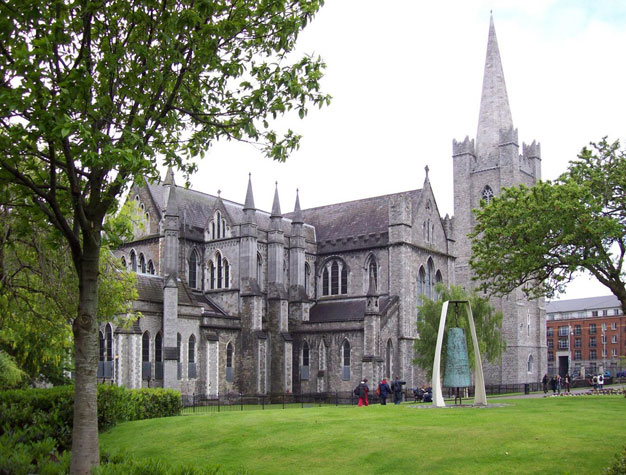
This is a photograph of St. Patrick Church in Dublin, Ireland. It is one of the sites pilgrims will see on The Catholic Messenger’s pilgrimage to Ireland Aug. 31 to Sept. 9.
By Barb Arland-Fye
The Catholic Messenger
St. Patrick, the saint whose feast we celebrate today, March 17, arrived in fifth-century Ireland as a teen-age captive and not a visitor, but he grew to love the people of the Emerald Isle. St. Patrick’s dependence on and deepening love for God inspired many in his adopted homeland to convert to Christianity.
The Catholic Messenger invites you to explore St. Patrick’s adopted homeland — its natural beauty and some of its historic religious sites — on the “Faith of the Irish” pilgrimage to Ireland with Bishop Thomas Zinkula. Picture yourself celebrating Mass at some of these historic religious sites, with Bishop Zinkula presiding! The pilgrimage takes place Aug. 31 to Sept. 9.
Among the places pilgrims will visit is Armagh, Ireland’s ecclesiastical capital and home to two cathedrals named after St. Patrick. This town in northern Ireland features towering church spires, hilly streets and historic buildings. Its lineage “stretches back to St. Patrick in the fifth century AD…Patrick reputedly had a stone church built on a hill here back in 445 AD” (ireland.com). Bishop Zinkula will preside at Mass at St. Patrick’s Cathedral, followed by Holy Hour. Participants will travel through St. Patrick’s country to Downpatrick. According to tradition, St. Patrick was buried in 461 on Cathedral Hill within the grounds of Down Cathedral. The group will visit the museum dedicated to St. Patrick and see his burial site.
Another attraction with a deep connection to St. Patrick is the Holy Mountain of Croagh Patrick where the saint is said to have fasted for 40 days. “Croagh Patrick, which overlooks Clew Bay in County Mayo, is considered the holiest mountain in Ireland. Its religious significance dates back to the time of the pagans, when people are thought to have gathered here to celebrate the beginning of harvest season” (discoverireland.ie).
Pilgrims will take in the scenery on their travels from Connemara to Kylemore Abbey, where they will celebrate Mass. Afterwards, the group will head to Galway where many of the pubs serve great food accompanied by Irish music.
Other major sites along the pilgrimage include Dublin, the Shrine of Our Lady of Knock, the Cliffs of Moher, the Blarney Stone and Glendalough, site of an ancient monastic city that St. Kevin founded in the sixth century. It is in the heart of the valley of two lakes.
The pilgrimage offers time for prayer, reflection, walking, shopping and savoring the sites of a country whose religious and cultural heritage resonates with many Irish Americans today.
The opportunity to explore their ancestors’ roots is another draw for many Catholics and non-Catholics in our diocese. Some 170 years ago, the start of the potato famine that devastated Ireland caused starving Irish families to immigrate to America, in search of survival and hope for a decent life. Those who made their new homes in Iowa found here everything that Ireland was not in the mid-19th century, observes historian Tim Walch, an Irish American who serves on The Catholic Messenger’s Board of Directors.
Among the Irish who thrived in this country were the Sharon family, who established the Iowa Messenger in 1882, the forerunner of The Catholic Messenger. Now the paper pays homage to those Irish roots and editorial forebearers with a pilgrimage to Ireland!
Please join Bishop Zinkula and members of The Catholic Messenger staff for an informational meeting on March 23 at 2 p.m. that will provide more details about the “Faith of the Irish” pilgrimage. Interested persons may attend in person or virtually. The in-person gathering takes place at the St. Vincent Center (diocesan headquarters), 780 W. Central Park Ave., Davenport. To register for the online link, send an email to messenger@davenport
diocese.org











